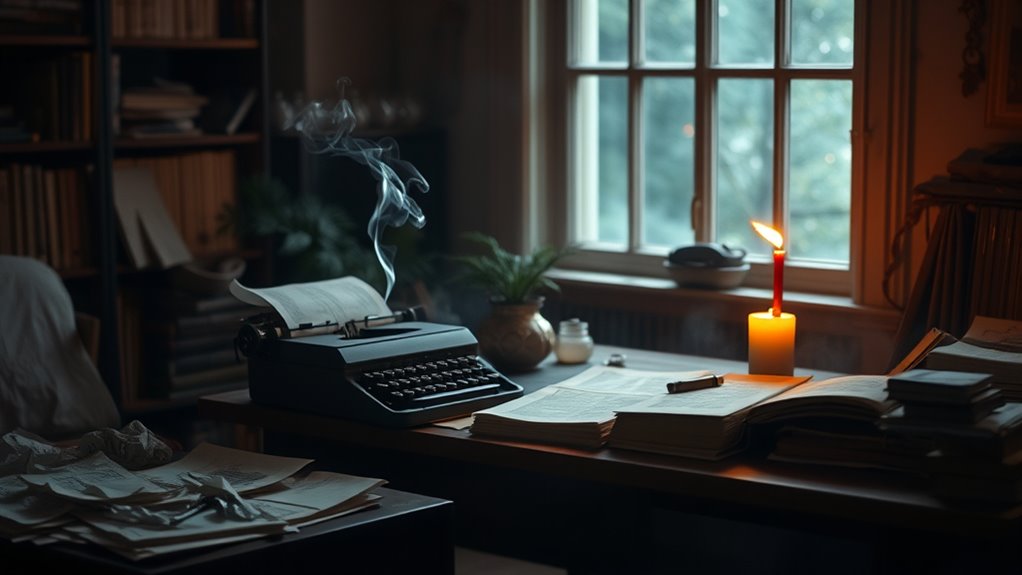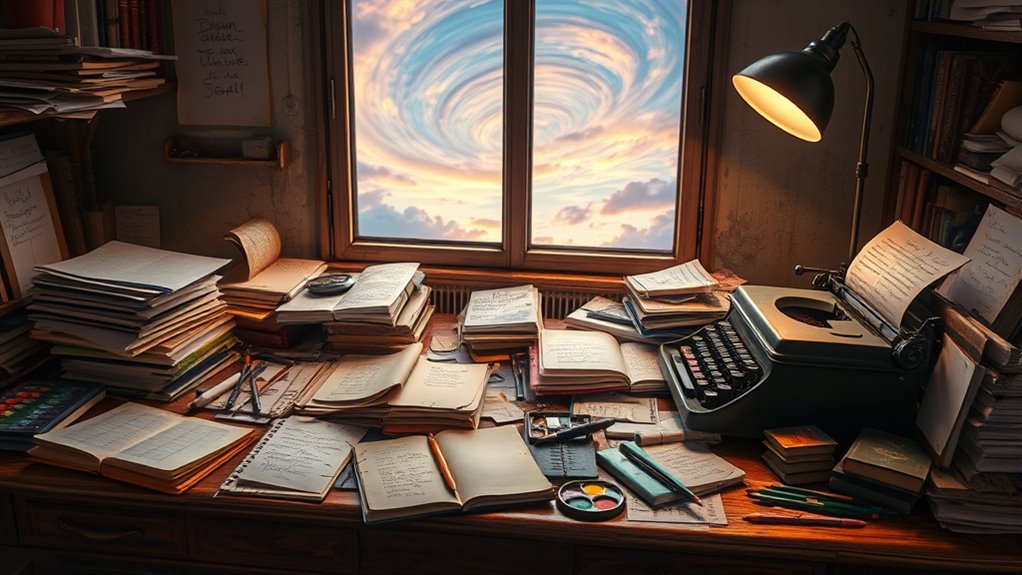Dreams are a potent source of inspiration for writers and artists, revealing subconscious imagery that fuels creativity. They often contain symbols, surreal scenes, and layered metaphors that can spark new ideas and perspectives. By paying attention to dream details and practicing techniques like keeping a journal or recognizing recurring themes, you tap into raw, innovative material. Exploring your dreams can help overcome creative blocks and add depth to your work—if you stay curious, you’ll discover even more ways to harness this inner world.
Key Takeaways
- Dreams serve as a subconscious wellspring, inspiring writers and artists with symbolic imagery and surreal landscapes.
- Recognizing and recalling dreams enhances creative ideas and helps overcome artistic blocks.
- Lucid dreaming allows artists to consciously interact with dream imagery, fostering original and authentic work.
- Analyzing recurring dream symbols provides deeper insight and innovative motifs for creative projects.
- Maintaining a dream journal and engaging with subconscious imagery enriches artistic expression and originality.

Dreams often serve as a hidden wellspring of inspiration, fueling creativity in ways that waking thoughts can’t always reach. When you explore the realm of your subconscious through lucid dreaming, you gain a unique opportunity to interact with your inner world consciously. Lucid dreaming allows you to recognize that you’re dreaming while still inside the dream, giving you a sense of control over the narrative. This awareness can lead to vivid explorations of subconscious imagery—strange scenes, symbolic objects, and surreal landscapes that feel both mysterious and profoundly meaningful. As you become more skilled at lucid dreaming, you can intentionally access these dreamscapes, teasing out details that spark ideas for your creative projects.
Lucid dreaming unlocks vivid subconscious imagery, inspiring creativity and new ideas for artists and writers alike.
In these dream states, subconscious imagery takes center stage, often presenting symbols and scenarios that your waking mind might overlook or dismiss. These images are rich with metaphor and layered meaning, providing you with fresh perspectives and innovative concepts. For a writer or artist, this means you can harness the power of your dreams to overcome creative blocks or find new directions. Instead of forcing ideas during the day, you can let your subconscious do the work overnight, waking up with vivid impressions or stories that feel both authentic and inspiring. By paying close attention to these dream symbols, you can interpret their significance and incorporate their essence into your work, adding depth and originality that stems directly from your inner world.
The process of engaging with subconscious imagery through lucid dreaming requires practice, but it pays off in genuine inspiration. As you get better at recognizing when you’re dreaming, you’ll start to remember more of your dreams and their details. Keeping a dream journal by your bedside can help reinforce your recall, so you can revisit these images and analyze their meaning. Over time, you’ll notice recurring themes or symbols that can become motifs in your creative projects. This conscious interaction with your dreams blurs the line between the waking and dreaming worlds, allowing ideas to flow more freely and authentically.
Ultimately, your dreams become a bridge to your subconscious, a fertile ground for innovative thought. By cultivating lucid dreaming and paying attention to subconscious imagery, you tap into a well of raw material that can elevate your art or writing to new heights. It’s about trusting your inner world and allowing it to inform your creative voice—turning intangible dreams into tangible masterpieces.
Frequently Asked Questions
How Can Artists Intentionally Harness Dreams for Inspiration?
You can harness dreams for inspiration by practicing lucid dreaming, which helps you control and explore your dreams consciously. Keep a dream journal by your bed, and jot down ideas as soon as you wake up to capture vivid details. Regularly reviewing your journal sparks new connections and creative insights. Combining lucid dreaming with consistent dream journaling transforms your subconscious into a powerful source of artistic inspiration.
Do All Writers Experience Vivid Dreams Related to Their Work?
Not all writers experience vivid dreams related to their work, but many do. You might notice dream symbolism and subconscious influences shaping your ideas, sometimes providing unexpected inspiration. These dreams can reveal hidden emotions or themes you haven’t consciously considered. If you pay attention to them, you may discover new perspectives for your writing. Embracing these subconscious messages can deepen your creative process and enrich your storytelling.
Can Dream Analysis Improve Creative Problem-Solving in Art?
Like Alice stepping through the looking glass, dream analysis can open hidden insights for your creative process. By practicing lucid dreaming, you can intentionally explore your subconscious imagery, revealing ideas you might not access consciously. This deeper understanding can spark innovative solutions and inspire new artistic directions, turning dreams into a wellspring for your creativity. Embracing your dreams empowers you to solve problems with fresh perspective, much like unlocking a secret door.
What Are Common Dream Themes Among Successful Creatives?
You often experience common dream themes like symbolic imagery and recurring motifs that fuel your creativity. These symbols might include flying, falling, or transformative scenes, reflecting your inner ideas and struggles. Recognizing these patterns can help you tap into your subconscious, inspiring new artistic directions. Embrace these themes as they often reveal hidden insights, boosting your creative process and helping you produce more authentic and meaningful work.
How Does Sleep Quality Influence Creative Output?
Imagine your mind as a vibrant canvas, and good sleep hygiene as the gentle brushstrokes that keep it vivid. When your sleep quality improves, you awaken refreshed, allowing your creative subconscious to flow freely like a clear stream. Poor sleep clouds this process, dulling inspiration and muddling ideas. Prioritize restful nights to access deeper insights, fueling your creativity with fresh perspectives and innovative visions.
Conclusion
As you step back from your dreams, you’ll see how they’re like hidden gardens, bursting with untapped ideas waiting to be cultivated. Embracing these nighttime visions fuels your creativity, turning fleeting images into masterpieces. Trust in the mysterious dance between dreams and your work—like stars guiding you through the night. When you let your subconscious lead, your art becomes a vibrant tapestry woven from the threads of your deepest imagination.









